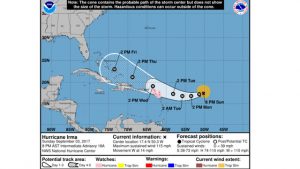 Antigua and Barbuda is on hurricane watch.
Antigua and Barbuda is on hurricane watch.
The twin-island state is among other Leeward Islands territories that have been upgraded to a watch as of 5.00 pm yesterday from being under an alert earlier in the day. Irma continues to move toward the islands near 14 miles per hour.
Montserrat, St. Kitts and Nevis, Anguilla, Saint Maarten, St. Martin and Saint Barthelemy are also now being closely monitored as the storm nears.
A hurricane watch means that hurricane conditions pose a possible threat to the specified area within 48 hours and as such the meteorological office is urging that residents start implementing their hurricane disaster plans. Up to press time lastnight, the centre of hurricane Irma was located near latitude 17.6 north, longitude 49.8 west or about 790 miles east of the Leeward Islands.
Hurricane Irma is expected to continue a westward to west-southwestward motion with some reduction in forward speed expected through tonight.
The center of Irma is expected to approach the northern Leeward Islands late tomorrow.
In the meantime, the National Office of Disaster Services (NODS), is advising residents, especially in flood prone areas, to make early plans about evacuation.
“If you are going to leave, don’t wait until the last moment. That determination should be made early especially if you have transportation logistics to think about” said Sherrod James deputy director at NODS. “If you have extended families, uncles, grandparents, aunts and persons with mobility challenges in your care, you have to make these arrangements now as to who stays with whom.”
The deputy director is also reminding persons who will need to go to shelters that they will be in a public space and rules and regulations will apply.
“It is managed space and they will go through registration and everyone will be expected to follow the rules. We ask persons to take a gallon of water per person per day, dried foods, crackers, canned foods, children formula, medications and basic necessities”, said James.
“No cooking, pets or drinking will be allowed in the shelters.”
The authorities are advising residents not to panic but be prepared and do more to mitigate against possible flooding.
“A lot of people are worrying about the flooding aspect but a lot of times when you look in the blocked culverts and drains it’s not coming from just anywhere in the environment but every time you throw away something on the ground it’s going to end up somewhere,” he said.
“There are a lot of areas where there should be no reason for flooding other than from the fact that rubbish has gotten in the drains and have blocked these culverts. It [is] a balancing act. We have to do things as a society, but we also have to be doing things as individuals.”
